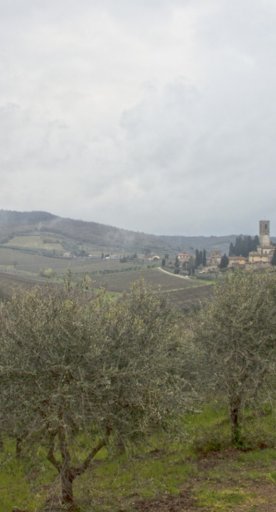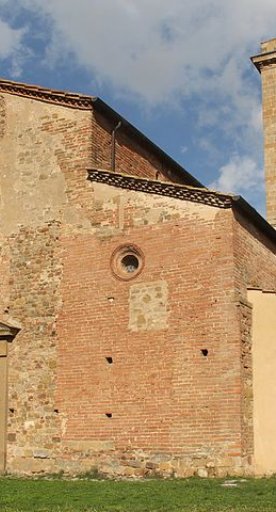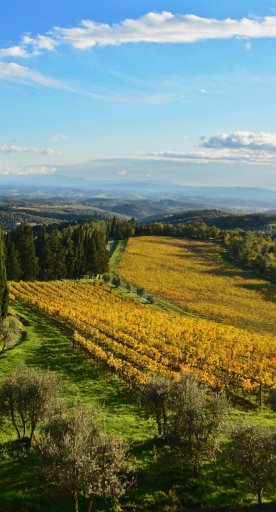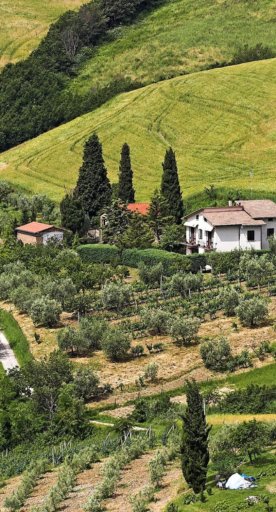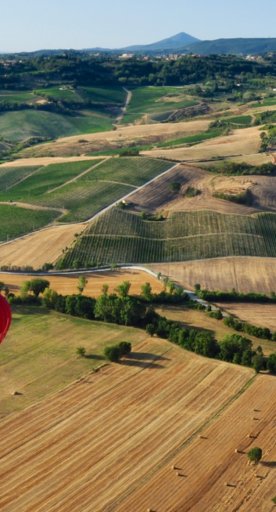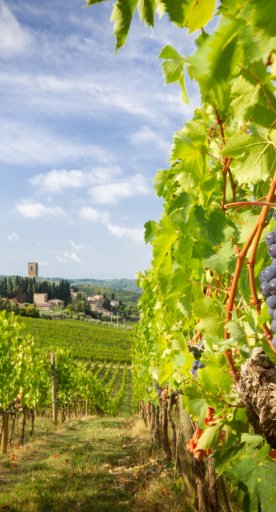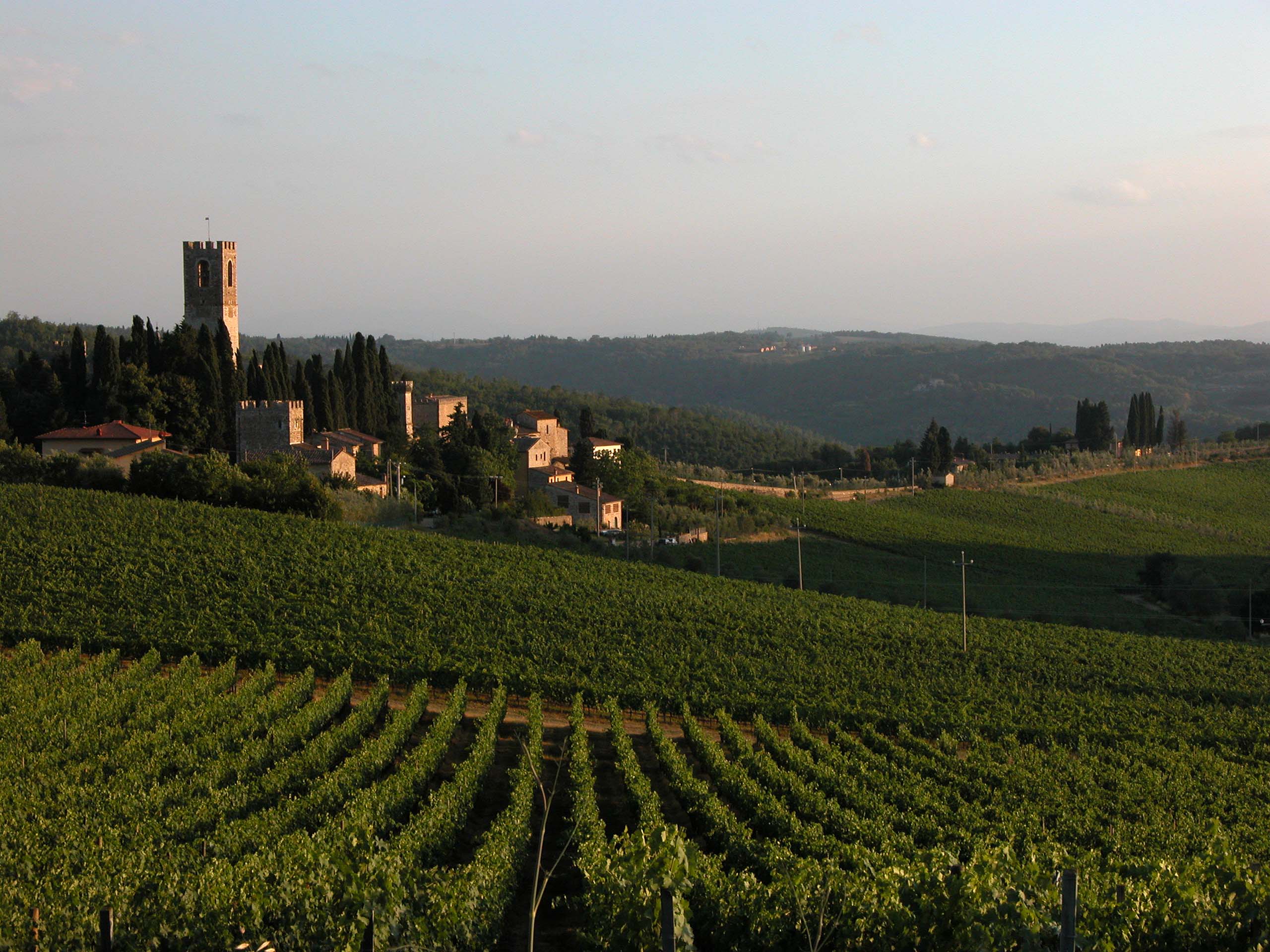Barberino Tavarnelle
Churches, villages and parish churches in the Val d’Elsa and Val di Pesa
Barberino Tavarnelle is located in a great position between the Val d’Elsa and Val di Pesa. Here, we are in the heart of Chianti, not far from Florence, in a part of Tuscany that's not too crowded and filled with charming, hidden corners. The municipality was established on January 1, 2019 following the merger of Barberino Val d'Elsa and Tavarnelle Val di Pesa.
What to see in Barberino Tavarnelle
The historic centre of Barberino has retained its medieval structure, with its Florentina and Sienese gates and its defensive towers overlooking the Drove valley. The history of the town dates to the early 1200s when the Florentines destroyed Semifonte in 1202 and used Barberino - due to its uphill position - against the landowner allies of the empire. Today, in commemoration of Semifonte, a temple stands at the top of a hill consisting of a cupola just like Brunelleschi’s in Florence, but eight times smaller.
Isolated in the countryside but not far from the center of Barberino, it’s certainly worth visiting the charming basilica of Sant’Appiano, often referred to as the oldest in Chianti and one of the most beautiful Romanesque churches in the area. The Santa Maria a Marcialla church, on the other hand, conceals a wonderful mystery: one of the side altars is topped by what is traditionally said to be a fresco painted by Michelangelo in his youth. The style resembles that of the great Renaissance artist and, deepening the mystery, beneath a marble slab by the altar you can still see some initials bearing the intertwined letters MBF, which some say is the young Buonarroti’s tag (make sure you ask the priest’s permission before moving the stone).
For a long time, Tavernelle has been the rest stop along the “via regia” which once linked Florence and Siena (and therefore Rome). The area is enriched with a high number of churches and parish churches that boast a wealth of artworks. The Church of Santa Lucia al Borghetto, an ex-Franciscan convent, is home to an Annunciation by Neri di Bicci. Not far from Tavarnelle, in the hamlet Morrocco, you can visit the Church of Santa Maria del Carmine while in the rectory of the centuries-old Romanesque Parish Church of San Pietro in Bossolo, you'll find the Sacred Art Museum, home to works such as an important series of panel paintings made in 1473 by Neri di Bicci.
However, highlight of the area is likely to be the imposing Badia a Passignano, founded in 1049 by Vallombrosan monks. Immersed in the countryside and surrounded by a strong cultivation of olives, the abbey is striking for its fortress-like appearance, complete with walls and crenelated towers. Amongst the numerous works of art conserved here are the frescoes by Passignano (1601) in the church’s main chapel and the Last Supper, frescoed by Domenico and Davide Ghirlandaio (1476-77), in the monastery’s refectory.
Take a walk in San Donato in Poggio, a medieval village that conserves important ruins of its defense walls, the Renaissance Palazzo Malaspina, the Gothic Church of Santa Maria della Neve (from the 15th century) and the Parish Church of San Donato, which conserves a beautiful baptismal font in glazed terracotta by Giovanni della Robbia. Lastly, don’t miss the “Emilio Ferrari” Museum of Rural Life, where you can retrace the history of rural civilization in the Chianti.
The historic centre of Barberino has retained its medieval structure, with its Florentina and Sienese gates and its defensive towers overlooking the Drove valley. The history of the town dates to the early 1200s when the Florentines destroyed Semifonte in 1202 and used Barberino - due to its uphill position - against the landowner allies of the empire. Today, in commemoration of Semifonte, a temple stands at the top of a hill consisting of a cupola just like Brunelleschi’s in Florence, but eight times smaller.
Isolated in the countryside but not far from the center of Barberino, it’s certainly worth visiting the charming basilica of Sant’Appiano, often referred to as the oldest in Chianti and one of the most beautiful Romanesque churches in the area. The Santa Maria a Marcialla church, on the other hand, conceals a wonderful mystery: one of the side altars is topped by what is traditionally said to be a fresco painted by Michelangelo in his youth. The style resembles that of the great Renaissance artist and, deepening the mystery, beneath a marble slab by the altar you can still see some initials bearing the intertwined letters MBF, which some say is the young Buonarroti’s tag (make sure you ask the priest’s permission before moving the stone).
For a long time, Tavernelle has been the rest stop along the “via regia” which once linked Florence and Siena (and therefore Rome). The area is enriched with a high number of churches and parish churches that boast a wealth of artworks. The Church of Santa Lucia al Borghetto, an ex-Franciscan convent, is home to an Annunciation by Neri di Bicci. Not far from Tavarnelle, in the hamlet Morrocco, you can visit the Church of Santa Maria del Carmine while in the rectory of the centuries-old Romanesque Parish Church of San Pietro in Bossolo, you'll find the Sacred Art Museum, home to works such as an important series of panel paintings made in 1473 by Neri di Bicci.
However, highlight of the area is likely to be the imposing Badia a Passignano, founded in 1049 by Vallombrosan monks. Immersed in the countryside and surrounded by a strong cultivation of olives, the abbey is striking for its fortress-like appearance, complete with walls and crenelated towers. Amongst the numerous works of art conserved here are the frescoes by Passignano (1601) in the church’s main chapel and the Last Supper, frescoed by Domenico and Davide Ghirlandaio (1476-77), in the monastery’s refectory.
Take a walk in San Donato in Poggio, a medieval village that conserves important ruins of its defense walls, the Renaissance Palazzo Malaspina, the Gothic Church of Santa Maria della Neve (from the 15th century) and the Parish Church of San Donato, which conserves a beautiful baptismal font in glazed terracotta by Giovanni della Robbia. Lastly, don’t miss the “Emilio Ferrari” Museum of Rural Life, where you can retrace the history of rural civilization in the Chianti.
Typical products
Barberino Tavarnelle is located in the production area of Chianti Classico DOCG and Chianti Classico DOP Extra Virgin Olive Oil, two high quality products that identify this as the land of the 'Black Rooster'. Among the many specialties to taste, we recommend pork, cinta senese and wild boar salami.
Barberino Tavarnelle is located in the production area of Chianti Classico DOCG and Chianti Classico DOP Extra Virgin Olive Oil, two high quality products that identify this as the land of the 'Black Rooster'. Among the many specialties to taste, we recommend pork, cinta senese and wild boar salami.
What’s nearby?
Chianti


